Saltwater Intrusion and Freshwater Storage in Sand Sediments along the Coastline: Hydrogeological Investigations and Groundwater Modeling of Nauru Island
Abstract
:1. Introduction
1.1. Nauru: Overview of the Island
1.2. Previous Hydrogeological Studies
2. Materials and Methods
2.1. Island Characterization
2.1.1. Geomorphology and Geology
2.1.2. Piezometric Survey—Nauru Datum and Tidal Correction
- Reference time definition: A reference time (t0) is fixed with the aim of referring all the field measurements to a standard time. Furthermore, tobs is defined as the real time corresponding to the instant when the hydraulic head is observed in the monitoring well.
- Tide maximum variation definition: Analyzing the tide fluctuation curve it is possible to calculate the difference between minimum and maximum tide levels (∆T) that occur just before and after the groundwater head measurement. ∆t is the time lag between minimum and maximum tide level occurrences. Furthermore, the Tidal Lag (TL) can be used to evaluate the occurrence of the maximum or minimum level in the observed monitoring well. For the Nauru case, all tide data need to be corrected compared to the RL.
- Correction factor estimation: The correction factor (∆hi), which should be applied to the groundwater level measured at tobs, can be calculated through the following equation:where ∆T/∆t represents the tide level variation velocity and Ei is the efficiency for the monitoring well i. Consequently, (Ei∆T/∆t) is the groundwater level variation velocity due to the tide influence in the monitoring well considered.
- Groundwater level correction: Four cases are possible, as summarized in Figure 6:
- The observation time (tobs) and the reference time (t0) are both between the same maximum and minimum groundwater levels and the head in the monitoring well (hobs1) has been observed before the reference time t0 (Figure 6a)—in this case, ∆hi must to be subtracted from hobs1.
- The observation time (tobs) and the reference time (t0) are both between the same maximum and minimum groundwater level and the head in the monitoring well (hobs2) has been observed after the reference time t0 (Figure 6a)—in this case, ∆hi must to be added to hobs2.
- The observation time (tobs) falls before the maximum groundwater level but the reference time (t0) is after the same maximum (see hobs3 in Figure 6b)—in this case, the correction must account for the fact that from tobs to t0 the groundwater level increases and then decreases. This means that ∆hi must be added to hobs3, but now it should be considered that ∆hi = (∆hi,R − ∆hi,L) where ∆hi,R is the correction during the groundwater rising phase and ∆hi,L is the correction during the groundwater lowering phase.
- The observation time (tobs) falls after the minimum groundwater level but the reference time (t0) is before the same minimum (see hobs4 in Figure 6b)—in this case, the correction must account for the fact that from t0 to tobs the groundwater level decreases and then increases. This means that the ∆hi must be added to hobs4, but now it should be considered that ∆hi = (∆hi,L − ∆hi,R) where ∆hi,L is the correction during the groundwater lowering phase and ∆hi,R is the correction during the groundwater rising phase.
2.1.3. Electric Conductivity Survey
2.2. Bi-Dimensional Numerical Model
3. Results
3.1. Heads Distribution
3.2. Electric Conductivity Distribution and Exploitable Areas
3.3. Model Results
4. Discussion
- The wind: During the humid season (November/April), the winds blow from the West, while, in the dry season, they come from East. This means that the northern and southern coastal zone are not particularly exposed to the wave action, and consequently there is a smaller erosion of the sands [40].
- The morphology and petrography of the coastal zone: The coastal zone has a variable width, from 400 m close to the airport to a few meters close to Anabar Bay. Near the S1 and S18 monitoring wells, the Bottomside width is 180 m and the sediments mainly consist of by carbonate sands. The main difference is linked to the thickness of sediments: in S1 and S18 the sediments are 15 m thick. Other boreholes in the Bottomside had shown that the basement is around 6 m from the ground level in the eastern sector, 10 m close to the airport and only 3 m in the Anibar bay. The elevated thickness of the sandy sediments in the northern zone is probably the cause of the groundwater slowing down and of storage. Here, the flow circulation is therefore different from the other zones where instead, due to the presence of karst tunnels, the groundwater flows rapidly toward the sea.
- The bathymetry: Looking at the bathymetric maps of Nauru [45], it is possible to notice that in the northern sector the sea bottom declines smoothly compared, for example, to the Anabar Bay zone where submarine cliff is present. That probably allows the decrease of wave intensity in the northern sector, thereby determining the sand sedimentation and the freshwater storage in the S1 and S18 area.
5. Conclusions
- Unlike generally assumed, small island aquifers can not only host continuous freshwater lens in the central part of the island, but, unexpectedly, freshwater storage can also occur next to the coastline. In Nauru case, long-term investigations carried out by authors, have shown that those lenses are resilient to saltwater intrusion even in drought periods.
- A method to correct head measurements vs. tide has been proposed and applied to better characterize the groundwater flow patterns in small islands.
- Thanks to the investigations and the numerical modeling, it has been possible to clarify the mechanism for freshwater storage next to the seashore and the role played by the hydrogeological structure and aquifers hydraulic conductivity.
- In previous studies, the durability of freshwater lenses had not been proven yet; the characterization activities here presented cover a long period and show that freshwater lenses located along the coastline turn out to be resilient to drought and saltwater intrusion.
Supplementary Materials
Acknowledgments
Author Contributions
Conflicts of Interest
References
- White, I.; Falkland, T. Reducing groundwater vulnerability in Carbonate Island countries in the Pacific. In Climate Change Effects on Groundwater Resources: A Global Synthesis of Findings and Recommendations; Gurdak, J.J., Ed.; CRC Press: Boca Raton, FL, USA, 2011; Volume 27, pp. 75–110. ISBN 978-0-203-12076-7. [Google Scholar]
- South Pacific Applied Geoscience Commission. ADB Pacific Regional Action Plan on Sustainable Water Management; South Pacific Applied Geoscience Commission: Suva, Fiji, 2003. [Google Scholar]
- Falkland, T. From Vision to Action Towards Sustainable Water Management in the Pacific. In Theme 1 Overview Report, Water Resources Management; Ecowise Environmental: Camberra, Australia, 2002. [Google Scholar]
- White, I.; Falkland, T.; Perez, P.; Dray, A.; Metutera, T.; Metai, E.; Overmars, M. Challenges in freshwater management in low coral atolls. J. Clean. Prod. 2007, 15, 1522–1528. [Google Scholar] [CrossRef]
- Werner, A.D.; Sharp, H.K.; Galvis, S.C.; Post, V.E.A.; Sinclair, P. Hydrogeology and management of freshwater lenses on atoll islands: Review of current knowledge and research needs. J. Hydrol. 2017, 551, 819–844. [Google Scholar] [CrossRef]
- Falkland, T. Water resources issues of small island developing states. Nat. Resour. Forum 1999, 23, 245–260. [Google Scholar] [CrossRef]
- White, I.; Falkland, T. Practical Responses to climate change: Developing National Water Policy and Implementation Plans for Pacific Small Island Countries. In Water and Climate: Policy Implementation Challenges, Proceedings of the 2nd Practical Responses to Climate Change Conference, Canberra Australia, 1–3 May 2012; Engineers Australia: Canberra, Australia, 2012; pp. 439–449. [Google Scholar]
- Chen, Z.; Grasby, S.E.; Osadetz, K.G. Relation between climate variability and groundwater levels in the upper carbonate aquifer, southern Manitoba, Canada. J. Hydrol. 2004, 290, 43–62. [Google Scholar] [CrossRef]
- Ma, T.; Wang, Y.; Guo, Q. Response of carbonate aquifer to climate change in northern China: A case study at the Shentou karst springs. J. Hydrol. 2004, 297, 274–284. [Google Scholar] [CrossRef]
- Gattinoni, P.; Francani, V. Depletion risk assessment of the Nossana Spring (Bergamo, Italy) based on the stochastic modeling of recharge. Hydrogeol. J. 2010, 18, 325–337. [Google Scholar] [CrossRef]
- Scott, D.; Overmars, M.; Falkland, T.; Carpenter, C. Pacific Dialogue on Water and Climate; South Pacific Applied Geoscience Commission: Suva, Fiji, 2003. [Google Scholar]
- Ayers, J.F.; Vacher, H.L. Hydrogeology of an Atoll Island: A Conceptual Model from Detailed Study of a Micronesian Example. Groundwater 1986, 24, 185–198. [Google Scholar] [CrossRef]
- Bailey, R.T.; Jenson, J.W.; Olsen, A.E. Numerical modeling of Atoll Island hydrogeology. Groundwater 2009, 47, 184–196. [Google Scholar] [CrossRef] [PubMed]
- Nakada, S.; Umezawa, Y.; Taniguchi, M.; Yamano, H. Groundwater Dynamics of Fongafale Islet, Funafuti Atoll, Tuvalu. Groundwater 2012, 50, 639–644. [Google Scholar] [CrossRef] [PubMed]
- Vacher, H.L. Introduction: Varieties of carbonate islands and a historical perspective. In Geology and Hydrogeology of Carbonate Islands; Vacher, H.L., Quinn, T.M., Eds.; Elsevier: Amsterdam, The Netherlands, 1997; pp. 1–33. ISBN 0444815201. [Google Scholar]
- Adger, W.N. Social-Ecological Resilience to Coastal Disasters. Science 2005, 309, 1036–1039. [Google Scholar] [CrossRef] [PubMed]
- Hill, P.J.; Jacobson, G. Structure and evolution of Nauru Island, central Pacific Ocean. Aust. J. Earth Sci. 1989, 36, 365–381. [Google Scholar] [CrossRef]
- Wallis, I. Draft National Water Plan for Government of Nauru, Prepared in Cooperation with Ministry of Health; Workshop Notes September 2001, in press.
- Government of the Republic of Nauru. National Sustainable Development Strategy; Ministry of Finance and Economic Planning, Development Planning and Policy Division: Yaren, Nauru, 2005.
- South Pacific Applied Geoscience Commission. Sustainable Integrated Water Resources and Wastewater Management in Pacific Island Countries National IWRM Diagnostic Report, Nauru; South Pacific Applied Geoscience Commission: Suva, Fiji, 2007. [Google Scholar]
- Government of the Republic of Nauru. Nauru Water and Sanitation Master Plan; European Union: Brussels, Belgium, 2015.
- Nauru Project. Available online: http://nauru.como.polimi.it (accessed on 15 September 2017).
- Australian Bureau of Meteorology; CSIRO. Climate Change in the Pacific: Scientific Assessment and New Research. Volume 1: Regional Overview; Australian Bureau of Meteorology: Melbourne, Australia; CSIRO: Canberra, Australia, 2011; Volume 2. [Google Scholar]
- Falkland, T. Country Implementation Plan for Improving Water Security in the Republic of Nauru; South Pacific Applied Geoscience Commission: Suva, Fiji, 2010. [Google Scholar]
- World Health Organization. Total Dissolved Solids in Drinking-Water Background Document for Development of Health Criteria and other Supporting Information; World Health Organization: Geneva, Switzerland, 1996. [Google Scholar]
- Jacobson, G.; Hill, P.J.; Ghassemi, F. Geology and Hydrogeology of Nauru Island. In Geology and Hydrogeology of Carbonate Islands; Vacher, H.L., Quinn, T.M., Eds.; Elsevier: Amsterdam, The Netherlands, 1997; pp. 707–742. ISBN 0444815201. [Google Scholar]
- Jacobson, G.; Hill, P.J. Hydogeology and groundwater resources of Nauru Island, Central Pacific Ocean. Groundwater 1988, 12, 85. [Google Scholar]
- Romanazzi, A.; Gentile, F.; Polemio, M. Modelling and management of a Mediterranean karstic coastal aquifer under the effects of seawater intrusion and climate change. Environ. Earth Sci. 2015, 74, 115–128. [Google Scholar] [CrossRef]
- Ghassemi, F.; Jakeman, A.J.; Jacobson, G.; Howard, K.W.F. Simulation of seawater intrusion with 2D and 3D models: Nauru Island case study. Hydrogeol. J. 1996, 4, 4–22. [Google Scholar] [CrossRef]
- Bouchet, L.; Sinclair, P. Assessing the Vulnerability of Shallow Domestic Wells in Nauru; Technical Report 435; South Pacific Applied Geoscience Commission: Suva, Fiji, 2010. [Google Scholar]
- White, I.; Falkland, T. Management of freshwater lenses on small Pacific islands. Hydrogeol. J. 2010, 18, 227–246. [Google Scholar] [CrossRef]
- Alberti, L.; Cantone, M.; La Licata, I. Carried Out Activities in Nauru 24 November–1 December 2010. Available online: http://nauru.como.polimi.it/activities-report-november-2010/activities-report-november-2010 (accessed on 15 September 2017).
- Alberti, L.; Cantone, M.; La Licata, I.; Oberto, G. Carried Out Activities in Nauru 29 September–13 October 2011. Available online: http://nauru.como.polimi.it/activities-report-november-2010/activities-report-october-2011 (accessed on 15 September 2017).
- Alberti, L.; Cantone, M.; Oberto, G.; Sampietro, D. GNSS Static Suvey Report. Available online: http://nauru.como.polimi.it/activities-report-november-2010/gnss-nauru-survey-report-oct-2011 (accessed on 15 September 2017).
- Alberti, L.; La Licata, I.; Cantone, M. PROGETTO NAURU—Sintesi delle attività del primo anno. Available online: http://nauru.como.polimi.it/activities-report-november-2010/nauru-report-july-2011 (accessed on 15 September 2017).
- Dupon, J.F.; Bonvallot, J.; Florence, J. Pacific Phosphate Island Environments Versus the Mining Industry: An Unequal Struggle; South Pacific Regional Environment Programme, South Pacific Commission: Noumea CEDEX, New Caledonia, 1989. [Google Scholar]
- Barrett, P.J. Report on Phosphate, other Minerals and Groundwater Resources, and on Aspects of Rehabilitation Planning and Methodology, Nauru, Pacific Ocean; Commission of Inquiry into the Rehabilitation of Mined-out Phosphate Lands of Nauru: Menen, Nauru, 1988. [Google Scholar]
- Morrison, R.J.; Manner, H.I. Pre-mining pattern of soils on Nauru, Central Pacific. Pac. Sci. 2005, 59, 523–540. [Google Scholar] [CrossRef] [Green Version]
- Australia Geoscience. EDM Height Traversing Levelling Survey, Nauru; Australia Geoscience: Canberra, Australia, 2009.
- Maharaj, R.J. Evaluation of the Impacts of Harbour Engineering, Anibare Bay, Republic of Nauru (RON); Technical Report 316; South Pacific Applied Geoscience Commission: Suva, Fiji, 2011. [Google Scholar]
- Harbaugh, A.W. MODFLOW-2005, The U.S. Geological Survey Modular Ground-Water Model—The Ground-Water Flow Process; U.S. Department of the Interior: Washington, DC, USA, 2005; p. 253.
- Langevin, C.D.; Guo, W. MODFLOW/MT3DMS-based simulation of variable-density ground water flow and transport. Groundwater 2006, 44, 339–351. [Google Scholar] [CrossRef] [PubMed]
- La Licata, I.; Langevin, C.D.; Dausman, A.M.; Alberti, L. Effect of tidal fluctuations on transient dispersion of simulated contaminant concentrations in coastal aquifers. Hydrogeol. J. 2011, 19, 1313–1322. [Google Scholar] [CrossRef]
- Campana, C.; Fidelibus, M.D. Reactive-transport modelling of gypsum dissolution in a coastal karst aquifer in Puglia, southern Italy. Hydrogeol. J. 2015, 23, 1381–1398. [Google Scholar] [CrossRef]
- Kruger, J.; Sharma, A. Nauru Technical Report. High-Resolution Bathymetric Survey, Fieldwork Undertaken on 30 September 2005; EU EDF 8/9—SOPAC Project Report 116. Reducing Vulnerability of Pacific ACP States; South Pacific Applied Geoscience Commission: Suva, Fiji, 2008. [Google Scholar]
- Australian Bureau of Meteorology. Available online: http://www.abs.gov.au/websitedbs/d3310114.nsf/home/Consumer+Price+Index+Inflation+Calculator (accessed on 15 September 2017).
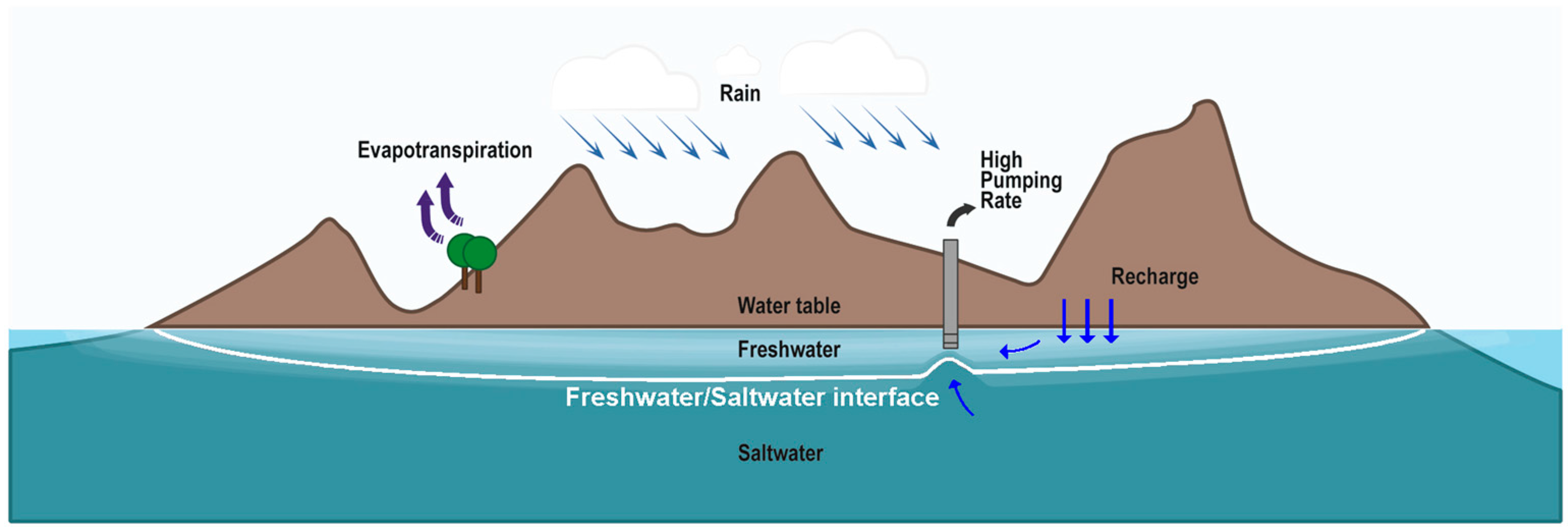

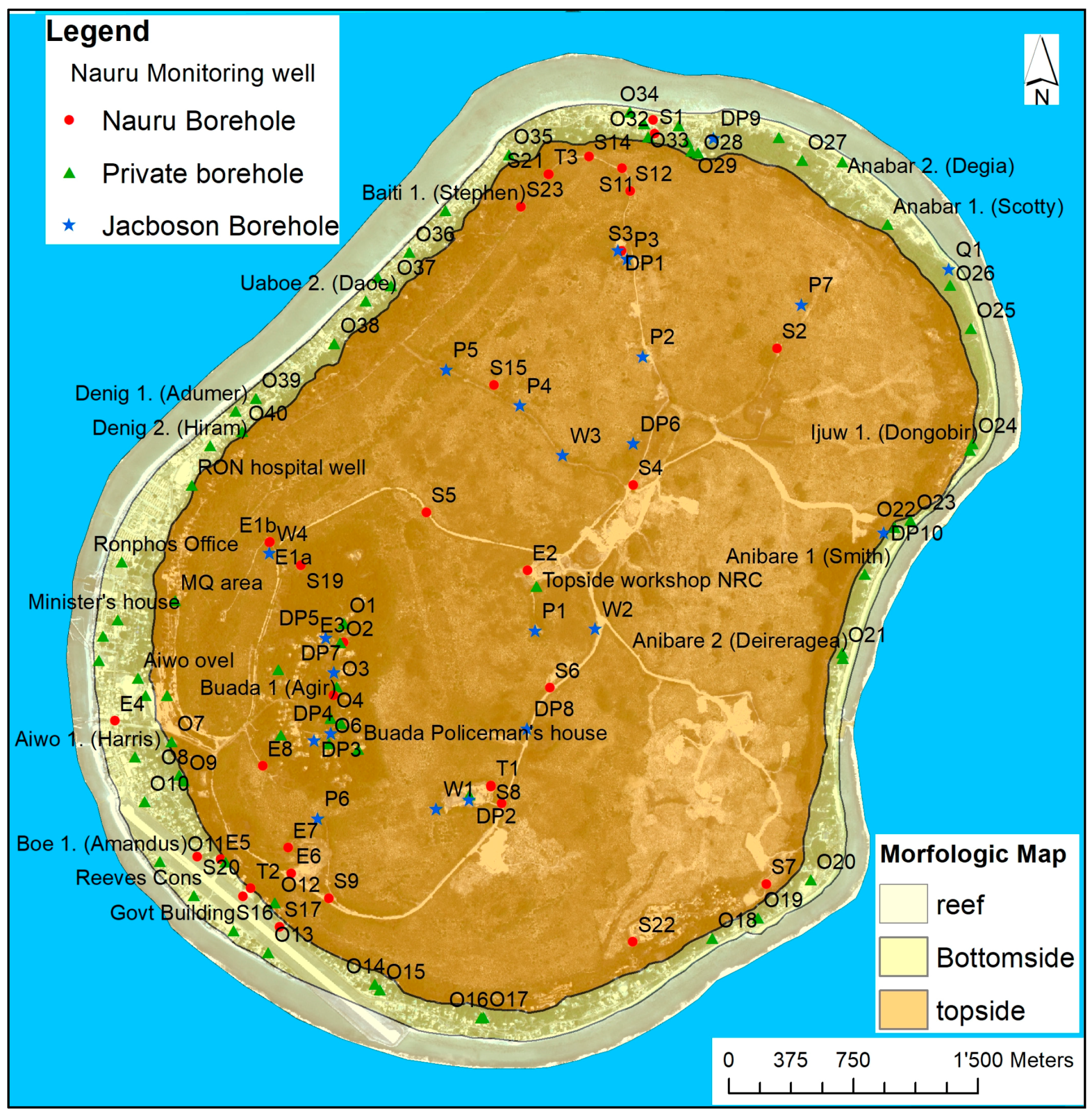
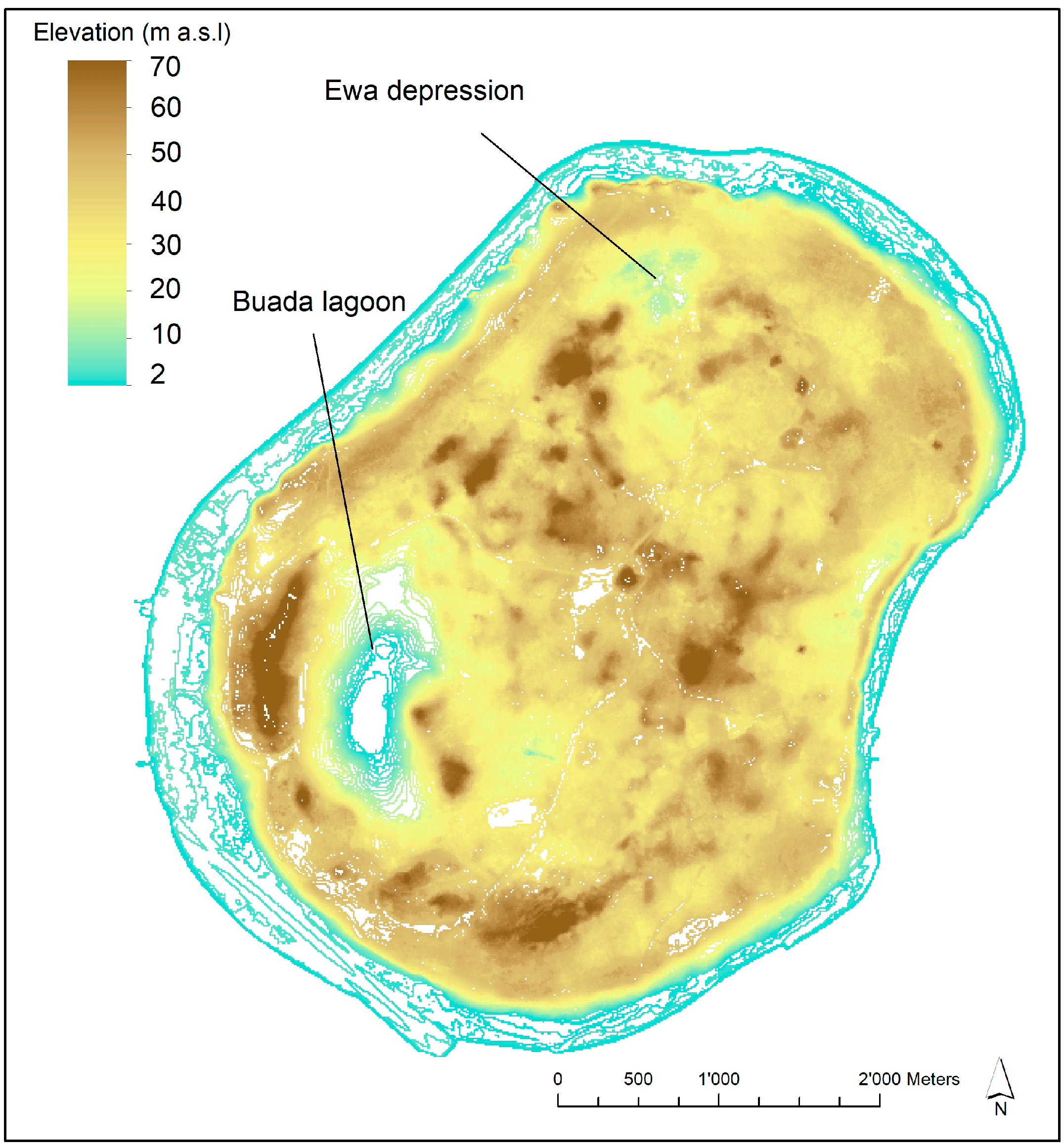




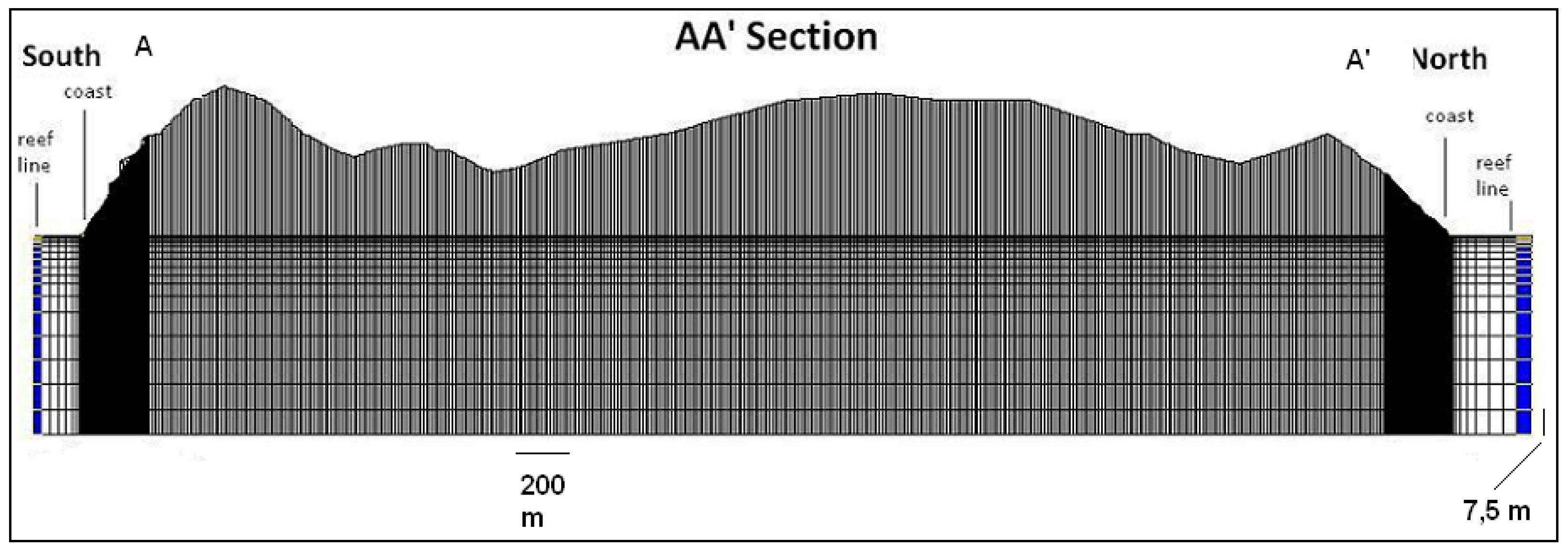


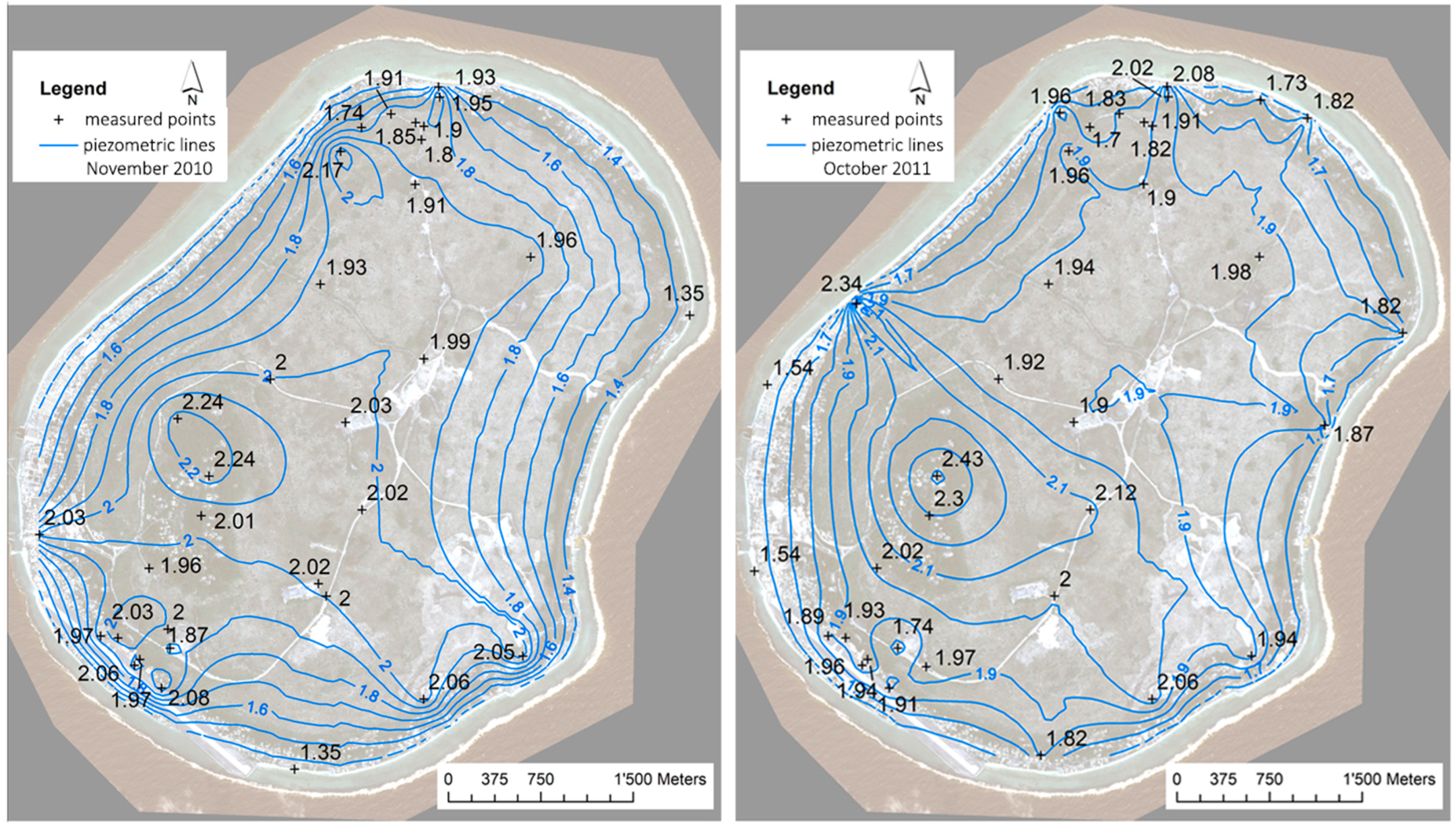

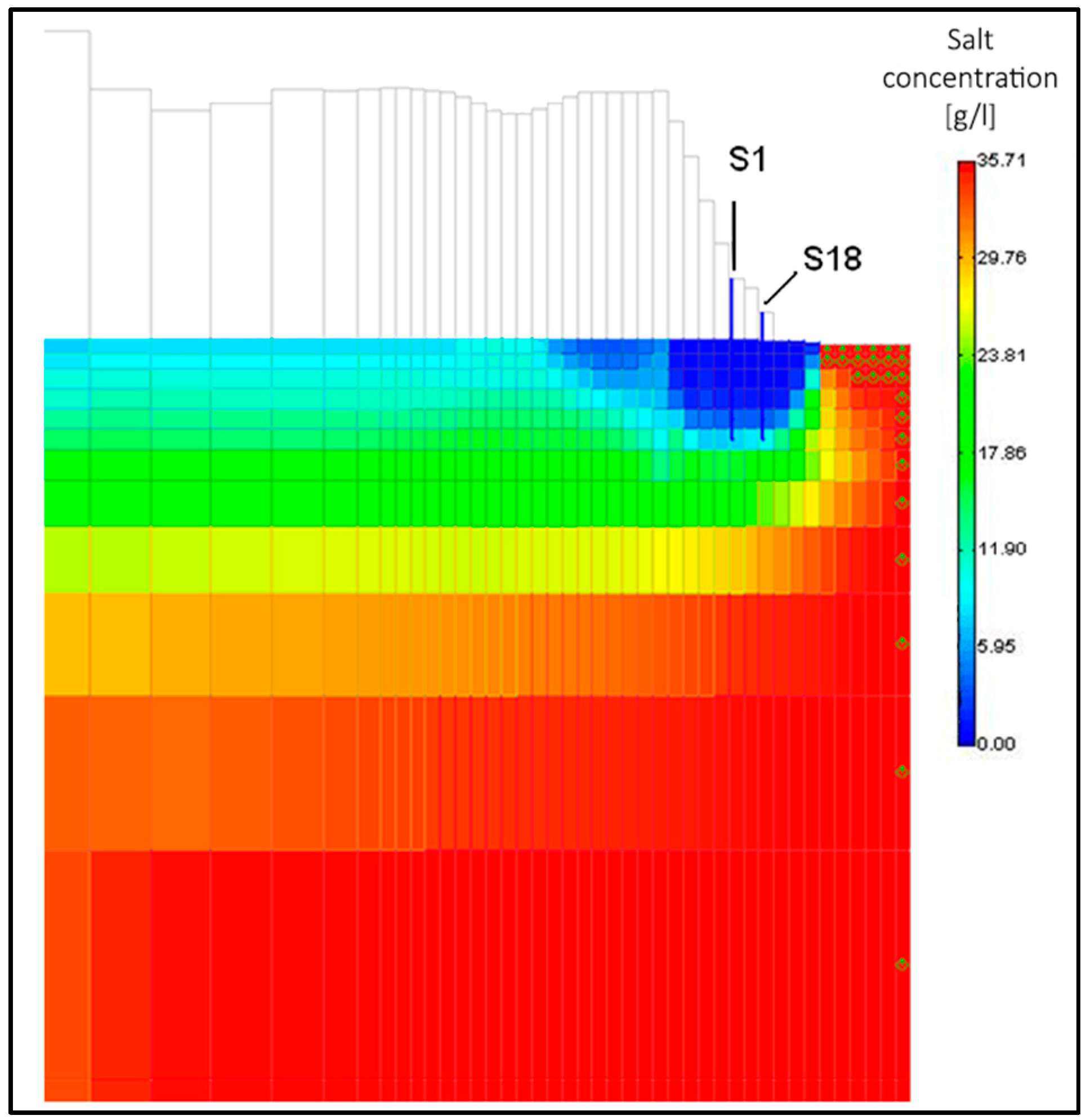
| Monitoring Well | Location | Average Tidal Lag (hours:min) | Average Tidal Efficiency (E) | Minimum Sea Distance (m) |
|---|---|---|---|---|
| E2 | Topside | 01:37 | 0.50 | 1950 |
| E3 | Topside | 01:27 | 0.54 | 1500 |
| E8 | Topside | 01:49 | 0.49 | 950 |
| S3 | Topside | 01:55 | 0.47 | 820 |
| S9 | Topside | 01:32 | 0.46 | 520 |
| S10 | Topside | 01:51 | 0.44 | 1400 |
| S11 | Topside | 01:23 | 0.50 | 340 |
| S15 | Topside | 01:31 | 0.54 | 1040 |
| S21 | Topside | 01:20 | 0.41 | 397 |
| S22 | Topside | 01:20 | 0.49 | 290 |
| T1 | Topside | 01:27 | 0.56 | 1500 |
| Average | Topside | 01:33 | 0.49 | |
| S1 | Bottomside | 01:17 | 0.50 | 140 |
| S16 | Bottomside | 02:10 | 0.27 | 280 |
| T2 | Bottomside | 01:27 | 0.56 | 342 |
| Average | Bottomside | 01:38 | 0.44 |
| Hydrogeological Parameter | Ghassemi Adopted Values | |
|---|---|---|
| Hydraulic conductivity (Kx, Kz) | 900 m/d | 18 m/d |
| Porosity | 0.3 | |
| Specific Storage and Specific Yield (Ss, Sy) | 0.0003 m−1 | 0.3 m−1 |
| Longitudinal dispersivity | 65 m | |
| Transverse dispersivity | 0.15 m | |
| Recharge | 540 mm/year | |
| Molecular diffusion | 8.64 × 10−6 m2/d | |
| Statistics | |
|---|---|
| Absolute Residual Mean | 1.70 |
| Residual Std. Deviation | 2.10 |
| RMS Error | 2.73 |
| Scaled RMS | 0.17 |
| Min. Residual | −0.28 |
| Max. Residual | 7.23 |
| Number of Observations | 16 |
| Range in Observations | 15.81 |
© 2017 by the authors. Licensee MDPI, Basel, Switzerland. This article is an open access article distributed under the terms and conditions of the Creative Commons Attribution (CC BY) license (http://creativecommons.org/licenses/by/4.0/).
Share and Cite
Alberti, L.; La Licata, I.; Cantone, M. Saltwater Intrusion and Freshwater Storage in Sand Sediments along the Coastline: Hydrogeological Investigations and Groundwater Modeling of Nauru Island. Water 2017, 9, 788. https://doi.org/10.3390/w9100788
Alberti L, La Licata I, Cantone M. Saltwater Intrusion and Freshwater Storage in Sand Sediments along the Coastline: Hydrogeological Investigations and Groundwater Modeling of Nauru Island. Water. 2017; 9(10):788. https://doi.org/10.3390/w9100788
Chicago/Turabian StyleAlberti, Luca, Ivana La Licata, and Martino Cantone. 2017. "Saltwater Intrusion and Freshwater Storage in Sand Sediments along the Coastline: Hydrogeological Investigations and Groundwater Modeling of Nauru Island" Water 9, no. 10: 788. https://doi.org/10.3390/w9100788





